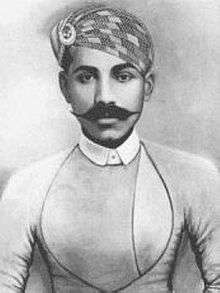Thug Behram

Thug Behra or Buhram (ca 1765–1840), also known as Buhram Jemedar and the 'King of the Thugs', was a leader of the Thuggee cult active in Oudh in northern central India during the late 18th and early 19th century, and is often cited as one of the world's most prolific serial killers. He may have been involved in up to 931 murders by strangulation between 1790–1840 performed with a ceremonial cloth (or rumal, which in Hindi means handkerchief), used by his cult.[1][2][3] Behram was executed in 1840 by hanging.
Biography
While Behram is sometimes suspected to have committed 931 murders, James Paton, an East India Company officer working for the Thuggee and Dacoity Office in the 1830s who wrote a manuscript on Thuggee, quotes Behram as saying he had "been present" at 931 cases of murder, and "I may have strangled with my own hands about 125 men, and I may have seen strangled 150 more."[4]
The English word 'Thug' is in fact borrowed from the Hindi word 'Thag'. The thugs were covert members of a group, and the term 'Thugee' typically referred to an act of deceitful and organised robbery and murder.[5]
Behram used his cummerbund as a rumal to execute his killings, with a large medallion sewn into it. With practised skill he could cast the rumal so as to cause the medallion to land at the adam's-apple of his victims, adding pressure to the throat when he strangled them. Finally he was executed by hanging in 1840
See also
References
- ↑ Dash, Mike (2005). Thug: The True Story of India's Murderous Cult. London: Granta pp.283-9
- ↑ The Top Ten of Everything 1996 (Page 65). ISBN 0-7894-0196-7
- ↑ Rubinstein, William D. (2004) Genocide: A History. Pearson Education Limited. p.83
- ↑ Paton, James. Collections on Thuggee and Dacoitee. British Library Add.Mss. 41300 fol. 118, 202–03
- ↑ William Sleeman. Rambles and Recollections of an Indian Official.